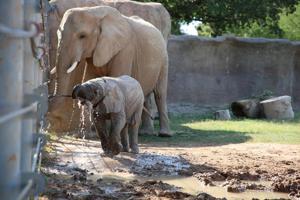Elephants use their trunks for a long list of reasons: eating, drinking, smelling, socializing. But trunks have about 40,000 individual muscles — and babies have to learn to use them. “Watching baby elephants figure that out — it’s kind of like trying to make a noodle work,” says Mara Eisenbarth, an elephant care specialist at Tucson, Arizona's Reid Park Zoo.
Meru loves to explore her habitat, including climbing over and around logs. Elephant calf Meru was born on March 8 to mama Semba at Reid Park Zoo. The 486-pound elephant calf joins sisters 9-year-old Nandi and 4-year-old Penzi, along with allomother Lungile.

Although the 3-month-old is still nursing — which she’ll do for several more years — she’s learning to use her trunk to pick up different pieces of food that the other elephants may have dropped. “She’s not really eating solids yet, but she’s trying to figure out what everyone else is eating,” Eisenbarth says. “For the most part, (calves) just kind of face plant onto things they want to eat.
She’s been more interested in hay and tree branches and she’ll come out with a few pieces.” Zoo staff are also helping Meru hone her trunk skills during training sessions, which are always voluntary for the elephants and done through positive reinforcement. Training allows staff to evaluate the elephants’ health and well-being.
“She’s learning to touch the tip of her trunk to our hand and we’ll put food into her trunk instead of into her .























